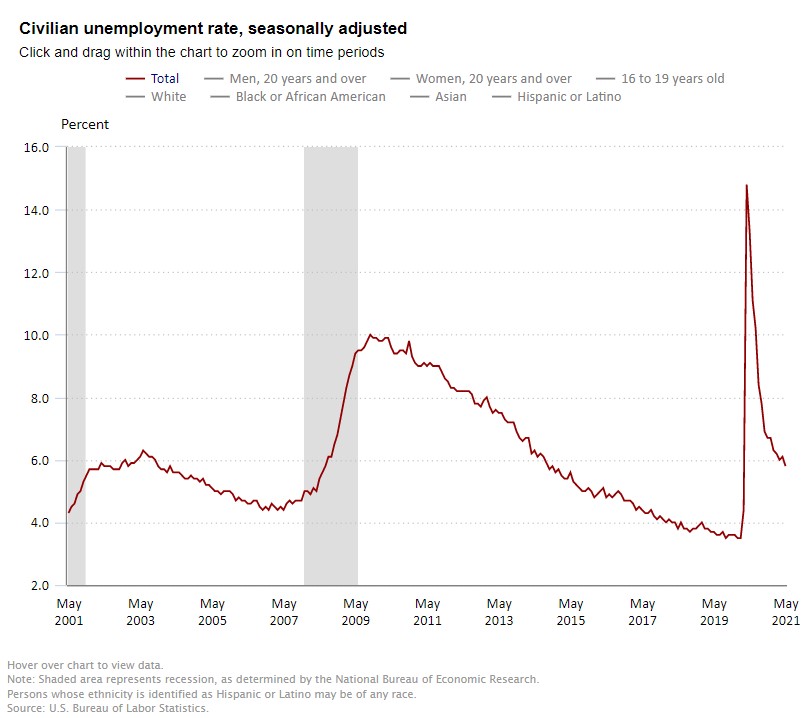The Labor Department reported that nonfarm payrolls rose by 559,000 in May 2021. The consensus estimates for May had been for a gain of 675,000. Revisions did little to improve the disappointing April 2021 gain of 278,000. Recent monthly job increases have been disappointing for this point in the recovery. Indeed, despite the increase, job levels remain 7.6 million below the pre-pandemic levels of February 2020.

Notable job gains occurred in leisure and hospitality (292,000), in public and private education (144,000) and in health care and social assistance (46,000). These were employment sectors most hurt during the pandemic.
Separately and from a separate survey, the Labor Department reported that the unemployment rate fell back 0.3 percentage point to 5.8% in May from 6.1% in April. The jobless rate is now 2.3 percentage points above the pre-pandemic level of 3.5% seen in February 2020, but well below the 14.7% peak seen in April 2020. The underemployment rate or the U-6 jobless rate was unchanged at 10.2% down from 10.4% in April 2021. This figure includes those who have quit looking for a job because they are discouraged about their prospects and people working part-time but desiring a full work week.
The number of long-term unemployed (those jobless for 27 weeks or more) declined by 438,000 to 3.8 million but is 2.6 million higher than in February 2020, suggesting that this continues to be a very challenging time for many Americans. Long-term unemployed persons account for 40.9% of the total number of unemployed persons.
The labor force participation rate, which is a measure of the share of working age people who are employed or looking for work was steady at 61.6% in May but is lower than in February 2020. Many workers have dropped out of the labor force since the pandemic began to take care of family members or out of fear of working and catching the virus. Indeed, in May, the number of persons not in the labor force who currently want a job was essentially unchanged over the month at 6.6 million but is up by 1.6 million since February 2020. These individuals were not counted as unemployed because they were not actively looking for work during the last 4 weeks or were unavailable to take a job.
Average hourly earnings for all employees on private nonfarm payrolls rose by $0.15 in May to $30.33, a gain of 2.2% from a year earlier and followed an increase of $0.21 in April. The data suggests that rising demand for labor associated with the recover from the pandemic may be putting upward pressure on wages. That said, the Labor Department warns that the pandemic has affected the ability to fully interpret the wage data due to the wide swings in employment trends.
The change in total nonfarm payroll employment for March was revised up by 15,000 from a gain of 770,000 to 785,000 and the change for April was revised up by 12,000 from 266,000 to 278,000. With these revisions, employment in April and March combined is 27,000 higher than previously reported. Monthly revisions result from additional reports received from businesses and government agencies since the last published estimates and from the recalculation of seasonal factors.
The May data was disappointing after weak job gains in April. It may reflect ongoing health-related concerns about the pandemic and the need for workers to still take care of family members, especially school-aged children. That said, the ongoing drop in COVID cases, the widespread distribution of vaccines, and a shift in consumer confidence should support a more complete re-opening of the economy and a fuller recovery in jobs in the coming months. The weak May number also suggests that the Fed will continue in its resolve to keep interest rates low as it pursues its full employment objective.
About Beth Mace
Beth Burnham Mace is a special advisor to the National Investment Center for Seniors Housing & Care (NIC) focused exclusively on monitoring and reporting changes in capital markets impacting senior housing and care investments and operations. Mace served as Chief Economist and Director of Research and Analytics during her nine-year tenure on NIC’s leadership team. Before joining the NIC staff in 2014, Mace served on the NIC Board of Directors and chaired its Research Committee. She was also a director at AEW Capital Management and worked in the AEW Research Group for 17 years. Prior to joining AEW, Mace spent 10 years at Standard & Poor’s DRI/McGraw-Hill as director of its Regional Information Service. She also worked as a regional economist at Crocker Bank, and for the National Commission on Air Quality, the Brookings Institution, and Boston Edison. Mace is currently a member of the Institutional Real Estate Americas Editorial Advisory Board. In 2020, Mace was inducted into the McKnight’s Women of Distinction Hall of Honor. In 2014, she was appointed a fellow at the Homer Hoyt Institute and was awarded the title of a “Woman of Influence” in commercial real estate by Real Estate Forum Magazine and Globe Street. Mace earned an undergraduate degree from Mount Holyoke College and a master’s degree from the University of California. She also earned a Certified Business Economist™ designation from the National Association of Business Economists.
Connect with Beth Mace
Read More by Beth Mace